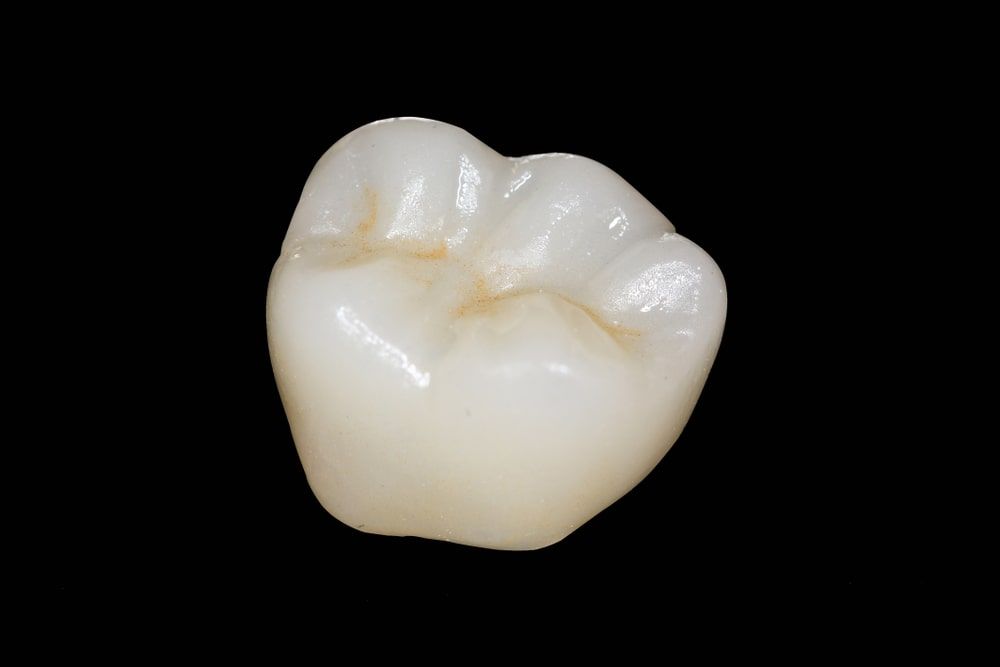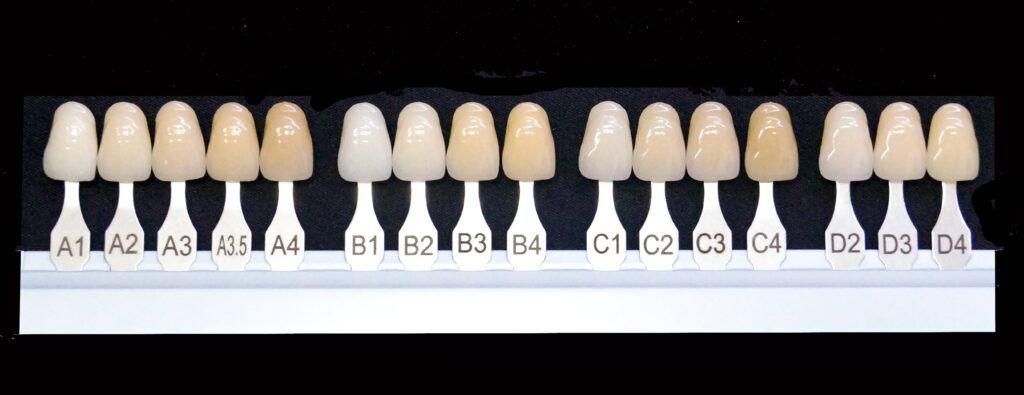A radiant smile can be a game-changer, boosting confidence and leaving lasting impressions. With advancements in cosmetic dentistry, achieving that perfect smile has never been more accessible. However, with various treatments available to alter the color of your teeth, how do you choose the right one and, more importantly, the right shade? Let’s dive in!
Cosmetic Dental Treatments to Alter Tooth Color
There are various types of cosmetic dental treatments that can alter the color of your teeth. The type of cosmetic dental treatment plays a significant role in how one should decide on a tooth color. Different treatments have varied implications for color selection, longevity, and overall aesthetics. Here’s a breakdown of different cosmetic dental treatments and how the type of treatment can influence the decision-making process for tooth color:
Teeth Whitening:
The most popular and non-invasive method, teeth whitening involves using bleaching agents to lighten the teeth. This treatment can be done in a dental office for immediate results or at home with custom-made trays. For teeth whitening treatments, one should consider:
- Natural Base Color: Since whitening enhances your natural tooth color by removing stains, the base color of your teeth will determine the end result. It’s essential to have realistic expectations; not all teeth will achieve a Hollywood-white shade.
- Extent of Discoloration: The type and degree of staining (surface stains vs. deep discoloration) can influence the effectiveness of the whitening and, consequently, the shade achieved.
Dental Veneers:
Thin shells made of porcelain or composite resin, veneers are bonded to the front surface of the teeth. They not only change the color but can also correct minor misalignments or gaps. When having veneers placed, one should consider:
- Coverage: Veneers cover the front surface of the teeth. Therefore, the chosen color should harmonize with surrounding natural teeth to ensure a consistent smile.
- Material: Porcelain veneers are more stain-resistant than composite ones. If opting for composite, consider a slightly lighter shade, anticipating potential future discoloration.
- Thickness: The opacity of the veneer and its thickness can affect how the underlying tooth color shows through. A very discolored tooth might require a thicker or more opaque veneer to mask the color effectively.
Dental Crowns:

Used primarily for damaged teeth, crowns cover the entire tooth. They can be made of porcelain, ceramic, or metal. When aiming for a natural look, porcelain or ceramic crowns are preferred due to their color-matching ability. Before having a dental crown placed, one should consider:
- Full Coverage: Crowns envelop the entire tooth. While they provide more coverage than veneers, the color choice is crucial to match adjacent teeth, especially if it’s a front tooth.
- Material: Ceramic and porcelain crowns offer a more natural look compared to metal-based crowns. The chosen material can influence the shade and translucency of the crown.
Dental Bonding:
A tooth-colored composite resin is applied to the tooth and then shaped and polished. Bonding can fix chipped, fractured, or discolored teeth. When having dental bonding performed, one should consider:
- Spot Treatment: Bonding is often used for spot treatments, like fixing a chipped tooth or closing a gap. The composite resin color should be an exact match to ensure the bonded area blends seamlessly.
- Stain Susceptibility: Composite resin is more prone to staining than natural teeth or porcelain. Regular maintenance and possibly choosing a slightly lighter shade can help counteract this.
Dentures and Bridges:
For those missing teeth, dentures and bridges not only restore function but can also offer a brighter smile with teeth-colored to your preference.When having a denture or bridge placed, one should consider:
- Multiple Teeth: Since these often replace multiple teeth, it’s essential to choose a color that looks natural and matches any remaining teeth.
- Material: The prosthetic teeth in dentures and bridges can be made from various materials, each with its own color properties and stain resistance.
General Considerations:
In addition to the aforementioned factors to consider depending on the exact treatment, there are a few general considerations when it comes to tooth color:
- Facial Aesthetics: Your skin tone, lip color, and even eye color can influence how a particular tooth shade looks. It’s essential to choose a shade that complements your overall appearance.
- Age Factor: Younger individuals might opt for brighter shades, while mature individuals might find slightly subdued shades to appear more natural.
- Longevity: Some treatments are more permanent than others. For long-lasting treatments, consider how the color might age or change over time.
Picking the Right Tooth Color
Choosing the right tooth color is a blend of science, aesthetics, and personal preference. While the type of cosmetic dental treatment plays a role, there are general guidelines and steps one can follow to ensure the chosen shade complements the overall appearance and looks natural. Here’s a step-by-step guide on how to go about it:
1. Professional Consultation:

- Expert Advice: Begin with a thorough consultation with your dentist or dental technician. They are trained to understand the nuances of tooth color and can provide recommendations based on your specific treatment and desired outcome.
- Shade Guides: Dentists use professional shade guides that offer a range of tooth colors. These guides help in comparing potential shades to your natural teeth, giving a clearer idea of what might work best.
2. Evaluate in Different Lighting:
- Natural Light: Always assess potential shades under natural light, as indoor or artificial lighting can distort the true color. If possible, view the shade outside or near a window during daylight.
- Multiple Settings: Check the shade in various lighting conditions, such as indoor, outdoor, and under fluorescent lights, to ensure it looks good in all scenarios.
3. Consider Surrounding Elements:
- Skin Tone: Your skin tone can influence how certain shades appear. A shade that complements your skin tone will ensure a harmonious and natural look.
- Lip Color: The contrast between your teeth and lip color can impact the perception of tooth whiteness. Ensure the chosen shade doesn’t clash with your natural lip color.
- Eye Color: While it’s a subtle factor, the color of your eyes can also play a role in the overall harmony of your facial features.
4. Think About Age and Lifestyle:
- Natural Aging: Teeth naturally yellow with age. Consider how the chosen shade will evolve over time and whether it will still look natural as you age.
- Dietary Habits: If you frequently consume beverages like coffee, tea, or red wine, be aware that these can stain certain dental materials over time. Discuss with your dentist about the best shade and material to counteract potential staining.
5. Seek Feedback:
- Trusted Opinions: Sometimes, a second or third opinion can provide clarity. Share your potential choices with trusted friends or family members to get their feedback.
- Temporary Trials: If possible, opt for treatments that allow for a trial period, like temporary veneers. This “test drive” lets you experience the shade in real-life settings before finalizing.
6. Trust Your Instincts:
- While technical factors and expert advice are essential, your comfort and satisfaction are paramount. If a particular shade feels right and boosts your confidence, it’s likely the right choice for you.
7. Maintenance and Care:
- Once you’ve chosen a shade, discuss with your dentist about the best ways to maintain it. Regular dental check-ups, good oral hygiene, and avoiding stain-causing foods can help preserve the color for longer.
In Conclusion
Cosmetic dental treatments offer a plethora of options to brighten and enhance your smile. While the technical aspects are crucial, the aesthetic outcome—especially the shade—plays a significant role in the overall success of the treatment. With the right guidance and considerations, you can achieve a smile that’s not only brighter but also authentically yours.

Dr. Sadati possesses extensive experience in all aspects of advanced restorative dentistry, with an emphasis in cosmetic and implant dentistry. He has attained Accredited Fellow status in the American Academy of Cosmetic Dentistry (AACD), the most rigorous, demanding credentialing process in the world. He is the only AACD Accredited Fellow in South Florida.


